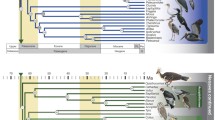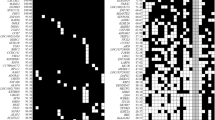Summary
Most avian systematists of the past century have thought that the accentors(Prunella) are most closely related to the thrushes (Turdinae). A few have favored the fringillids, and others have suggested the sylviids, parids, troglodytids, motacillids, mimids, cinclids or timaliids as close relatives ofPrunella.
Comparisons were made between the single-copy DNA sequences of the Dunnock(Prunella modularis) and those of 28 other species of Passeres representing all major groups of oscines. The ploceine finches were found to be most closely related toPrunella and the next nearest relatives include the motacillids, sunbirds,Passer, and the fringillids. These groups are members of the superfamily Fringilloidea. The thrushes, starlings, mockingbirds, muscicapine flycatchers, and dippers (= Muscicapoidea); the sylviine warblers, babblers, and tits (= Sylvioidea), and the monarch flycatchers, wrens, larks, waxwings, and Australian scrub-robins(Drymodes), are not closely related toPrunella.
Zusammenfassung
Die meisten Systematiker des vergangenen Jahrhunderts haben die Braunellen(Prunella) als nächst verwandt mit den Drosseln (Turdinae) angesehen. Einige haben die Finken, andere Grasmücken, Meisen, Zaunkönige, Stelzen, Spottdrosseln, Wasseramseln oder die Timalien als nächste Verwandte vonPrunella eingestuft.
Es wird die Methode der DNS/DNS-Hybridisierung beschrieben. Singuläre DNS-Sequenzen der Heckenbraunelle(Prunella modularis) wurden mit denen von 28 anderen, alle hauptsächlichen Oscinesgruppen repräsentierenden Passeres-Spezies verglichen. Die Ploceinen erwiesen sich hierbei als die nächsten Verwandten vonPrunella. In zweiter Linie zeigten die Stelzen, Sonnenvögel,Passer und die Finken Verwandtschaften zuPrunella. Diese Gruppen sind in der Überfamilie Fringilloidea zusammengefaßt. Nicht so eng verwandt mitPrunella erscheinen die Drosseln, Spottdrosseln, Fliegenschnäpper und Wasseramseln (= Muscicapoidea), die Grasmücken, Timalien und Meisen (= Sylvioidea) sowie die Monarchfliegenschnäpper, Zaunkönige, Lerchen, Seidenschwänze und die Australischen Malleevögel(Drymodes).
Similar content being viewed by others
Literature
Ames, P. L. (1975): The application of syringeal morphology to the classification of the Old World insect eaters (Muscicapidae). Bonn. Zool. Beitr. 26: 107–134.
Beecher, W. J. (1953): A phylogeny of the oscines. Auk 70: 270–333.
Bentz, G. D. (1979): The appendicular myology and phylogenetic relationships of the Polceidae and Estrildidae (Aves: Passeriformes). Bull. Carnegie Mus. Nat. Hist. 15: 1–25.
Berlioz, J. (1950): Systematique. In: Traité de Zoologie, vol. 15. Oiseaux, p. 845–1055.P. P. Grassé, ed. Masson et Cie., Paris.
Berndt, R. &W. Meise (1960): Naturgeschichte der Vögel. Vol. 2; 679 pp. Franckh', Stuttgart.
Bock, W. J. &J. J. Morony, Jr. (1978): Relationships of the passerine finches (Passeriformes: Passeridae). Bonn. Zool. Beitr. 29: 122–147.
Bonner, T. I., R. Heinemann &G. J. Todaro (1981): A geographic factor involved in the evolution of the single copy DNA sequences of primates. In: Evolution Today, Proc. Second Int. Congr. Syst. Evol. Biol.G. G. E. Scudder andJ. L. Reveal, eds.
Bulatova, N. S. (1973): A cytotaxonomic study of three related families of birds: Fringillidae, Emberizidae, Polceidae. Z. für Zool. Systematik und Evolutionsforschung 11: 233–239.
Commorford, S. L. (1971): Iodination of nucleic acids in vitro. Biochem. 10: 1993–2000.
Dementiev, G. P. &N. A. Gladkov (1954): Ptitsy sovetskogo soyuza. Vol. 6. (Engl. transl. Birds of the Soviet Union, 1968. U.S. Dept. of Commerce, Washington, D. C.).
Evans, A. H. (1899): Birds. Macmillan and Co., London.
Fitch, W. M. (1976): Molecular evolutionary clocks. In: Molecular Evolution: 160–178.F. J. Ayala, ed. Sinauer Associates, Sunderland, Mass.
Harrison, C. J. O. (1976): The syrinx of the southern Scrub-robinDrymodes brunneipygia (sic). Emu 76: 154.
Hartert, E. (1910): Die Vögel der Paläarktischen Fauna. Vol. 1. Berlin.
Heinroth, O. &M. Heinroth (1921–1926): Die Vögel Mitteleuropas. Vol. I. Berlin.
Jacob, J. (1978): Uropygial gland secretions and feather waxes. In: Chemical Zoology: 165–211. Academic Press, New York.
Ditto &A. Zeman (1971): Vergleichende Untersuchung der Bürzellipide vom Grünfink(Carduelis chloris), Gimpel(Pyrrhula pyrrhula) und Hänfling(Carduelis cannabina). Z. f. Naturf. 26b: 1352–1356.
Knowlton, F. H. (1909): Birds of the world. Henry Holt, New York.
Kohne, D. E. (1970): Evolution of higher-organism DNA. Quart. Rev. Biophysics 33: 327–375.
Marmur, J. (1961): A procedure for the isolation of deoxyribonucleic acid from micro-organisms. J. Mol. Biol. 3: 208–218.
Mayr, E. &D. Amadon (1951): A classification of recent birds. Amer. Mus. Novitates No. 149: 1–42.
Ditto &J. C. Greenway, Jr. (1956): Sequence of passerine families. Breviora 58: 1–11.
Nathans, D. &H. O. Smith (1975): Restriction endonucleases in the analysis and restructuring of DNA molecules. Ann. Rev. Biochem. 44: 273–293.
Newton, A. (1896): A dictionary of birds. Adam and Charles Black, London.
Poltz, J. &J. Jacob (1973): Bürzeldrüsensekrete von Webervögeln (Ploceidae). Z. Naturf. 28c: 449–452.
Ditto (1974): Bürzeldrüsensekrete bei Ammern (Emberizidae), Finken (Fringillidae) und Webern (Ploceidae). J. Orn. 115: 119–127.
Prensky, W. (1976): The radioiodination of RNA and DNA to high specific activities. In: Methods in Cell Biology, vol. 13: 121–152.D. M. Prescott, ed. Academic Press, New York.
Ripley, S. D. (1952): The thrushes. Postilla 13: 1–48.
Ditto (1964): Family Prunellidae. In: Check-list of birds of the world: 3–12.E. Mayr &R. A. Paynter, Jr., eds. Mus. Comp. Zool., Cambridge, Mass.
Seebohm, H. (1881): Catalogue of the Passeriformes, or perching birds, in the collection of the British Museum. Vol. 5, part 2. Trustees, British Museum, London.
Sharpe, R. B. (1883): Catalogue of the Passeriformes, or perching birds, in the collection of the British Museum. Vol. 7, part 4. Trustees, British Museum, London.
Shields, G. F. &N. A. Straus (1975): DNA-DNA hybridization studies of birds. Evolution 29: 159–166.
Short, L. L. &J. F. M. Horne (1978): Nectar-feeding of some ploceine weavers. Scopus 2: 53–58.
Sibley, C. G. (1968): The relationships of the “wren-thrush”,Zeledonia coronata Ridgway. Postilla 125: 1–12.
Ditto (1970): A comparative study of the egg-white proteins of passerine birds. Bull. Peabody Mus. Nat. Hist. 32: 1–131.
Ditto (1976): Protein evidence of the relationships of some Australian passerine birds. Proc. 16th Int. Orn. Congr. pp. 557–570.
Ditto &J. E. Ahlquist (1981a): The relationships of the “primitive insect eaters” (Aves: Passeriformes) as indicated by DNA-DNA hybridization. Proc. 17th Int. Orn. Congress.
Ditto (1981b): The phylogeny and relationships of the ratite birds as indicated by DNA-DNA hybridization. In: Evolution Today, Proc. Second Int. Congr. Syst. Evol. Biol.: 303–337.G. G. E. Scudder andJ. L. Reveal, eds. Hunt Institute for Botanical Documentation, Pittsburgh, Pennsylvania, USA.
Ditto. (In press, a): The relationships of the Hawaiian honeycreepers (Drepaninini) as indicated by DNA-DNA hybridization. Auk.
Ditto. (In press, b): The relationships of the Wrentit(Chamaea fasciata) as indicated by DNA-DNA hybridization. Condor.
Ditto. (In press, c): The relationships of the Yellow-breasted Chat(Icteria virens), and the alleged “slow-down” in the rate of macromolecular evolution in birds. Postilla.
Ditto. (In press, d): The relationships of the Australo-Papuan scrub-robins(Drymodes) as indicated by DNA-DNA hybridization. Emu.
Ditto. (In press, e): The relationships of the vireos (Vireoninae) as indicated by DNA-DNA hybridization. Wilson Bulletin.
Ditto. (In press, f): The relationships of the wagtails and pipits (Motacillidae) as indicated by DNA-DNA hybridization. L'Oiseau et R. F. O.
Stresemann, E. (1934): Aves. In:Kükenthal &Krumbach, Handbuch der Zoologie, Bd. 7, 2. Teil. Walter de Gruyter, Berlin.
Sundevall, C. J. (1872): Methodi naturalis avium disponendarum tentamen. Samson and Wallin, Stockholm. Eng. trans. byF. Nicholson, 1899. Taylor and Francis, London.
Thomson, A. L. (1964): A new dictionary of birds. Thomas Nelson, London.
Vaurie, C. (1959): The birds of the Palearctic fauna. Passeriformes. H. F. andG. Witherby, London.
Watson, J. andF. H. C. Crick (1953): Molecular structure of nucleic acids. A structure for deoxyribose nucleic acid. Nature 171: 737–738.
Wetmore, A. (1930): A systematic classification for the birds of the world. Proc. U.S. Nat. Mus. 76 (24) 8 p.
Ditto (1951): A revised classification for the birds of the world. Smithson. Misc. Coll. 117 (4): 1–22.
Ditto (1960): A classification for the birds of the world. Smithson. Misc. Coll. 139 (11): 1–37.
Witherby, H. F., F. C. R. Jourdain, N. F. Ticehurst, andB. W. Tucker (1940): The Handbook of British Birds, Vol. 2 H. F. and G. Witherby, London.
Author information
Authors and Affiliations
Rights and permissions
About this article
Cite this article
Sibley, C.G., Ahlquist, J.E. The relationships of the Accentors(Prunella) as indicated by DNA-DNA hybridization. J Ornithol 122, 369–378 (1981). https://doi.org/10.1007/BF01652925
Published:
Issue Date:
DOI: https://doi.org/10.1007/BF01652925




